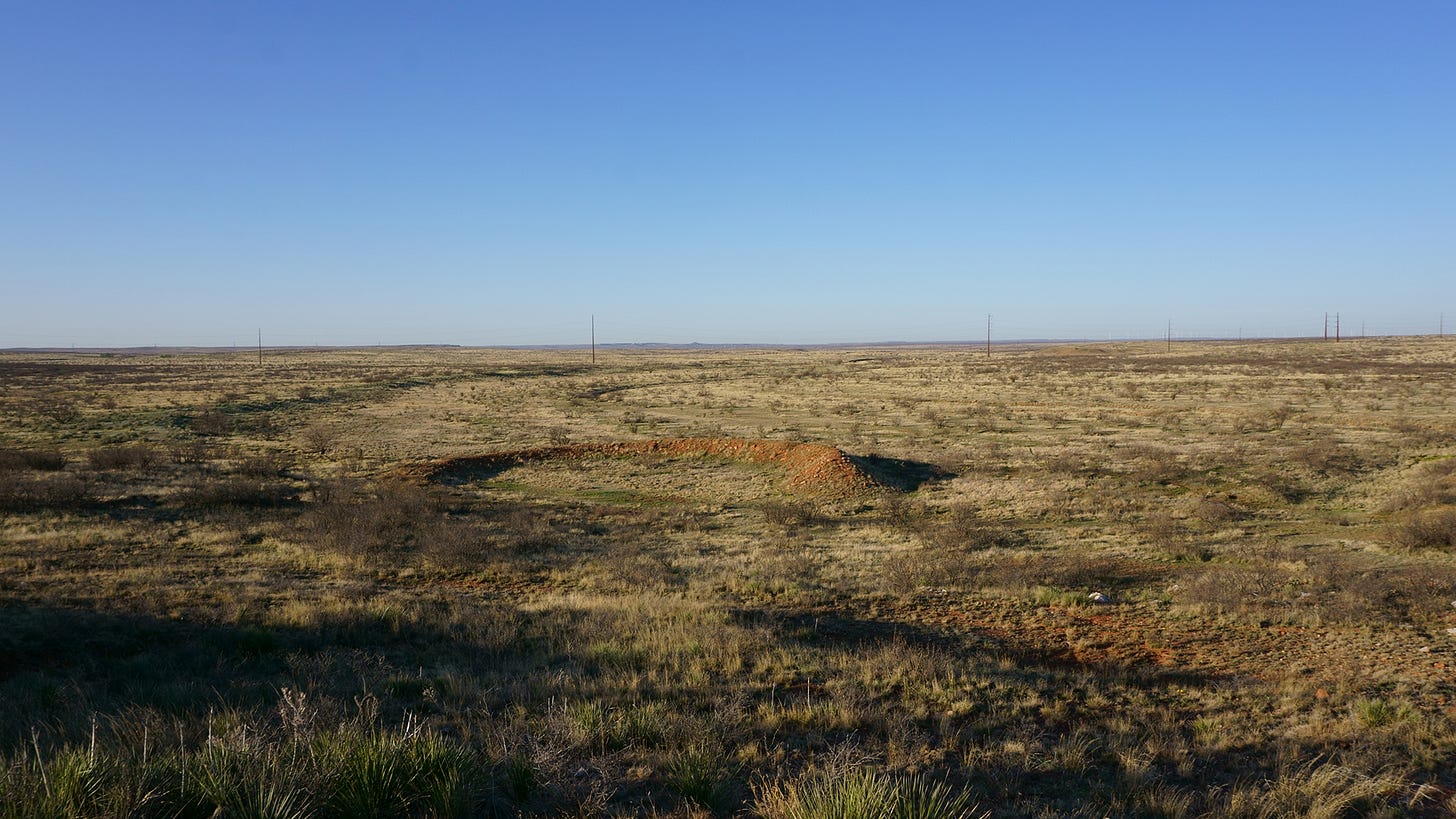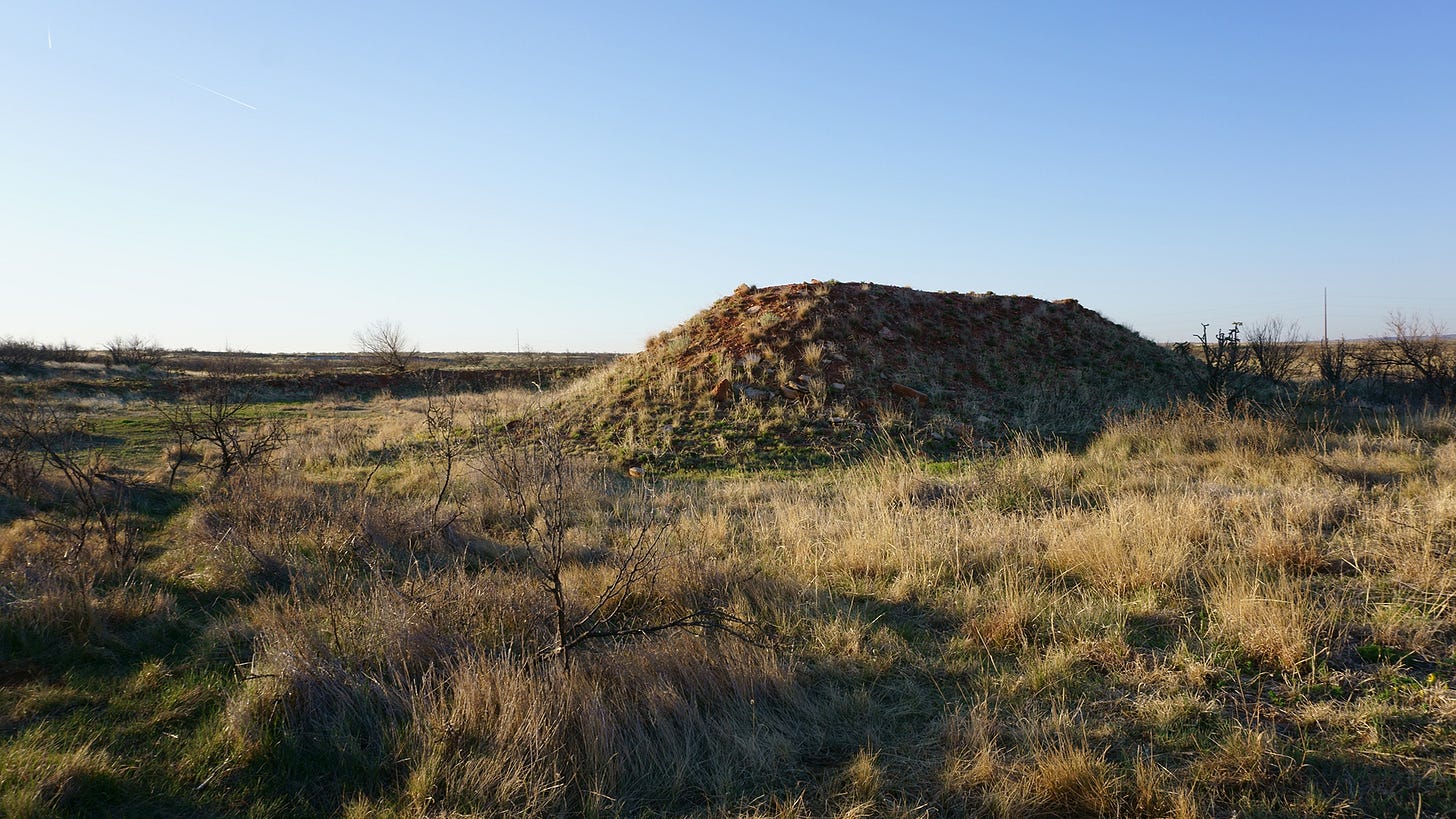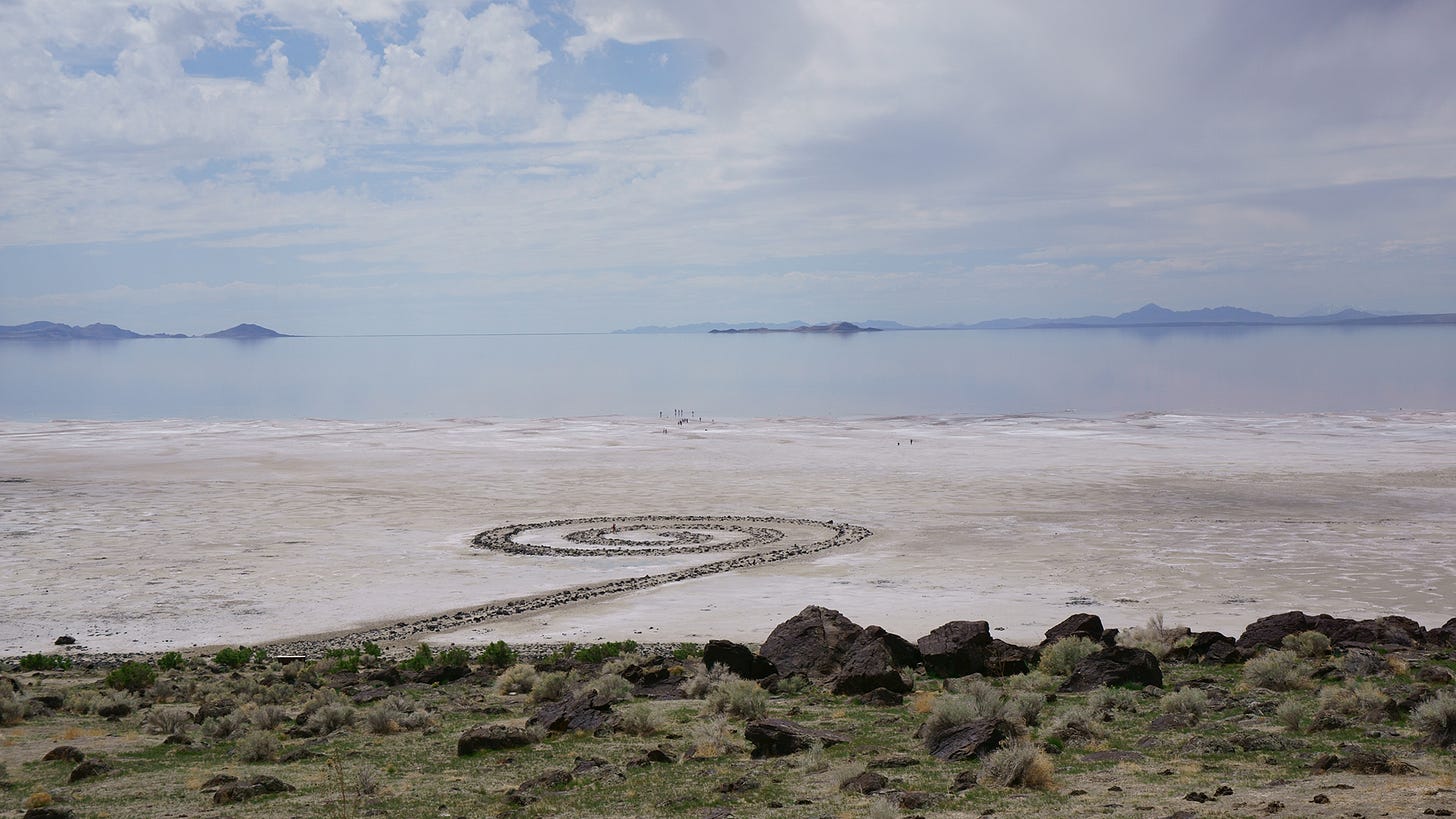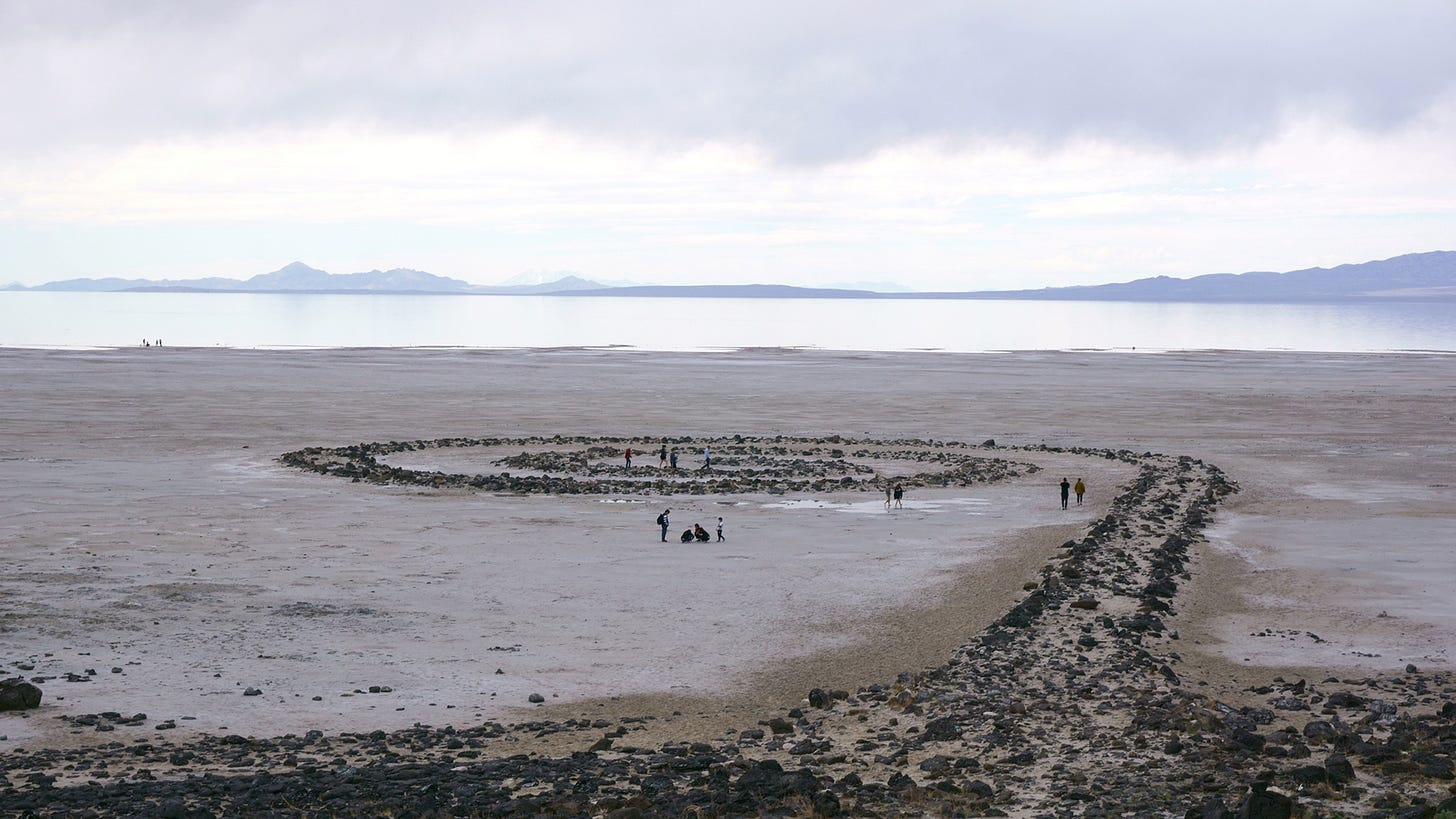Encounters with American Earthworks
I recently went to see Amarillo Ramp at sunrise on a blisteringly cold and windy morning. The Ramp was the beginning of a road trip from Houston to Salt Lake City, done as part of a Research Fellowship with the Holt/Smithson Foundation with the goal of visiting two Robert Smithson projects: Amarillo Ramp (1973) and, a week later, Spiral Jetty (1970). Amarillo and Salt Lake City are far from the usual coastal destinations of LA and New York, so the hurdle of distance immediately puts the two artworks under the burden of heightened anticipation.
One friend described Spiral Jetty as overly macho and imposing, even brutally insensitive to the environment. They said it was reflective of the same forces that are destroying the planet: a desire to rend the earth just to make a statement. A little unfair, I thought, but on my part the greater concern was that I would simply see the Ramp and the Jetty, shrug, and leave, stuck with the thought that it would’ve been enough to “see” the work through photographs instead.
We drove out to the Marsh Ranch, parking on the little hill that overlooks the ramp. Bradley (my tour guide) and I got out to watch the sun as it slowly rose from the flatness. Within twenty minutes the sky was turning blue, and the dry ground began to glow a yellowish green as the sunlight snaked its way from the horizon towards us. We walked down a footpath, passing the rock which marked where a small plane carrying Smithson went down in 1973, killing the artist at the age of thirty-five.
Imagine crashing into your work. When you’re in Amarillo you grasp how Smithson’s tragic death could’ve transpired. This is the windiest place in the United States; even on a relatively fair May morning it’s possible to see how a pilot could easily lose control if accosted by a Great Plains gust at the wrong time. Amarillo is precarious. Its winds are laden with existential dread, as they threaten to sweep away all life. The howl fills our ears, and its force slowly erodes the artwork, returning it to artificial lakebed. As we walk the ramp, Bradley reminds me that Amarillo is called Bomb City, because the city is where nuclear weapons are put together and taken apart. Amarillo also makes up a quarter of all the United States’ beef processing capacity with its many slaughterhouses and meatpacking plants. In some post-apocalyptic sense, it’s appropriate that death is a leading economic force here. About 300,000 people live in Amarillo, but the place feels desolate. It’s like an island in the ocean, but an island suggests some measure of stability; instead, Amarillo feels like a moment in time buffeted by infinity on all sides. If people stop eating beef or using nukes, all that would remain is a stop-over town on the way to other things; eventually that would probably disappear as well. The wind here is more than an element, it's a dimension. The wind is time itself, flattening everything into the empty horizon.
I walked the ramp’s red ring and soon reached the summit. Here we are. Now what? What do I think? Was it worth it? Maybe in an intellectual way more than in an emotional or aesthetic way. If the goal is “seeing” the ramp, then texts and photos may be sufficient to “get” the work. Another question follows: when does the visit to the ramp begin? Does it begin when you step onto the ranch or when you see the ramp itself? Or does it begin when you set out for Amarillo, riding that religious vortex from thousands of miles away that inevitably pulls you in?
When you’re in the middle of a 70,000-acre ranch (approximately half the size of Bahrain, where I live) in the middle of a sea of endless plains, then the intervention doesn’t seem particularly macho. The scale of everything here is so immense that nothing can contest it. Nothing compares to the sheer nothingness of the Panhandle. Smithson's ramp is not a monument; it’s a small act of authorship against a withering, wuthering vastness. It's a message in a bottle floating in the ocean, a gesture that marks the earth without chauvinism or bravado. It says “I was here,” but acknowledges that this makes no difference: “I was here, but so was everyone else.”
Spiral Jetty surpasses all expectations. It’s simply and unequivocally incredible. It feels less like an installation and more like some great inevitability. You ask not why it exists but why it did not always exist. Then you ask why there aren't more Spiral Jetties. The artwork is covered in crystals, a frozen whirlpool of glittering basalt tumbling in from black hills nearby into the sand. Smithson's work, after being submerged for twenty years, is now visible after the water levels in the Great Salt Lake have dropped. (Similarly, Amarillo Ramp lost its connection to Tecovas Lake, which has also dried up.) The landmark has eroded over time, subject to the same forces which act on the lake, making it more a part of the landscape than some manmade intrusion.
Onsite, I was surprised by the number of tourists walking the spiral, jogging, and camping. Some sat around the rocks talking about the Jetty while others arrived at the mirror-like edge of the Great Salt Lake to wade barefoot in the pink-blue water. This work of art activates the entire landscape. It’s almost architectural, as the spiral coaxes people out of their habits and the various radii that circumscribe their lives.
Visiting Spiral Jetty and Amarillo Ramp are similar acts of pilgrimage into less-than-exceptional landscapes. The works act as a human-made geology that compensates for the absence of cloyingly gorgeous geologic wonders that otherwise litter the American West. These works might begin on the hills that overlook them, as they introduce the spiral and circle at a distance, but I think they begin after you decide to set out and see them yourself. They start when you've passed the threshold of the familiar and are confronted with the unremarkable landscapes that constitute most of the surface of our planet.
Several things make Spiral Jetty more impressive than Amarillo Ramp. The Jetty is larger and more permanent than the Ramp. Its surroundings are mountains and salt lakes, which are a bit more beautiful than the interminably flat, rugged cow-scape of the Texas Panhandle. Seeing other people around also helps affirm the decision to make the journey—you’re part of some collective activity and, like a voyeur, able to see others engage with Smithson's work. Most of all, in contrast to the Ramp, which felt like an effort to assert human existence in the face of cosmic death, the Jetty feels essential in a different way. It draws people to the edge of a disappearing body of water in the midst of a changing ecosystem; it’s like visiting an unlikely, fleeting, beautiful moment in geologic time. Spiral Jetty is the kind of thing that makes life worth living.
A version of this text was previously shared by Karimi via his Instagram account @aikarimi on June 20, 2021.







